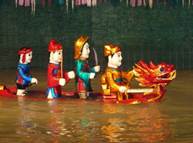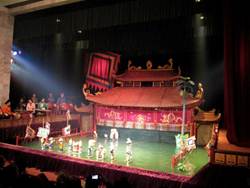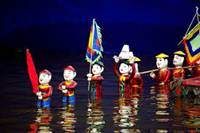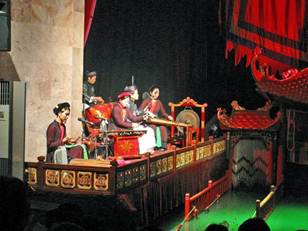News & Updates
Lotus - A trusted name in family travel
Ancient Art: “Soul of the Rice Fields”
 Water Puppetry ( Múa rối nước, lit. " puppets that dance on water") is a tradition
that dates back as far as the 11th century when it originated in the villages of northern Vietnam. Today's Vietnamese water puppetry is a unique variation on the ancient Asian puppet tradition.
Water Puppetry ( Múa rối nước, lit. " puppets that dance on water") is a tradition
that dates back as far as the 11th century when it originated in the villages of northern Vietnam. Today's Vietnamese water puppetry is a unique variation on the ancient Asian puppet tradition. Modern water puppetry is performed in a pool of water 4 meters square with the water surface being the stage. Performance today occurs on one of three venues: on traditional ponds in villages where a staging area has been set up, on portable tanks built for traveling performers, or in a specialized building where a pool stage has been constructed.

The puppets are made out of wood and then lacquered. The shows are performed in a waist-deep pool. A large rod supports the puppet under the water and is used by the puppeteers, who are normally hidden behind a screen, to control them. Thus the puppets appear to be moving over the water.
The exact time when water puppetry began in Vietnam is not known, but an early record of the art was found on a stone stele dating back to the 11th century eulogizing the merits of King Ly Nhan Tong. After a period of rapid development from the 11th-14th centuries, the art of water puppetry escaped the confines of the royal palaces of the Le and Nguyen dynasties and began showing up at village festivals and ceremonies, thus jump-starting the development of the country's traditional stage arts.

“Soul of the Rice Fields”
Rice, the main staple of the Vietnamese diet, grows in a water paddy. The original water puppet festivals were literally held inside a rice paddy, with a pagoda built on top to hide the puppeteers who stand in the waist-deep water. The water acts as the stage for the puppets, and as a symbolic link to the rice harvest. In fact water puppetry has often been called the “Soul of the Rice Fields." The water also hides the puppet strings and puppeteer movements, improves the musical and vocal acoustics, and provides a shimmering lighting effect. A traditional Vietnamese orchestra provides background music accompaniment. The instrumentation includes vocals, drums, wooden bells,  cymbals, horns, gongs, and bamboo flutes. The bamboo flute's clear, simple notes may accompany royalty while the drums and cymbals may loudly announce a fire-breathing dragon's entrance. The puppets enter from either side of the stage, or emerge from the murky depths of the water.
cymbals, horns, gongs, and bamboo flutes. The bamboo flute's clear, simple notes may accompany royalty while the drums and cymbals may loudly announce a fire-breathing dragon's entrance. The puppets enter from either side of the stage, or emerge from the murky depths of the water.
The theme of the skits is rural and has a strong reference to Vietnamese folklore. It tells of day-to-day living in rural Vietnam and Vietnamese folk tales that are told by grandparents to their grandchildren. Stories of the harvest, of fishing and of festivals are highlighted. Legends and national history are also told through short skits. Many of the skits, especially those involving the tales of day-to-day living, often have a humorous twist.
This art form is unique to North Vietnam and only found its way to the world stage in recent years as a result of normalized relations with the West. During the early 1990s the country's three foremost companies, the National Puppet Theatre (Nhà hát Múa rối Trung Ương), the municipal Thăng Long Puppet Company (Nhà hát Múa rối Thăng Long) of Hanoi and the Hồ Chí Minh City Puppet Company (Đoàn Nghệ thuật Múa rối Thành Phố Hố Chí Minh) gained increased international attention.
Sources: Wikipedia, internet sources and angelfire.com